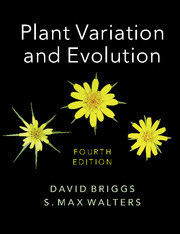Book contents
- Frontmatter
- Contents
- Preface to the Fourth Edition
- Acknowledgements
- Note on names of plants
- List of abbreviations
- 1 Investigating plant variation and evolution
- 2 From Ray to Darwin
- 3 Early work on biometry
- 4 Early work on the basis of individual variation
- 5 Post-Darwinian ideas about evolution
- 6 DNA: towards an understanding of heredity and molecular evolution
- 7 Breeding systems
- 8 Intraspecific variation and the ecotype concept
- 9 Pattern and process in plant populations
- 10 Pattern and process: factors interacting with natural selection
- 11 Populations: origins and extinctions
- 12 Species and speciation: concepts and models
- 13 Allopatric speciation and hybridisation
- 14 Abrupt speciation
- 15 The species concept
- 16 Flowering plant evolution: advances, challenges and prospects
- 17 Historical biogeography
- 18 The evolutionary impact of human activities
- 19 The taxonomic challenge ahead
- 20 Conservation: from protection to restoration and beyond
- Glossary
- References
- Index
13 - Allopatric speciation and hybridisation
Published online by Cambridge University Press: 05 June 2016
- Frontmatter
- Contents
- Preface to the Fourth Edition
- Acknowledgements
- Note on names of plants
- List of abbreviations
- 1 Investigating plant variation and evolution
- 2 From Ray to Darwin
- 3 Early work on biometry
- 4 Early work on the basis of individual variation
- 5 Post-Darwinian ideas about evolution
- 6 DNA: towards an understanding of heredity and molecular evolution
- 7 Breeding systems
- 8 Intraspecific variation and the ecotype concept
- 9 Pattern and process in plant populations
- 10 Pattern and process: factors interacting with natural selection
- 11 Populations: origins and extinctions
- 12 Species and speciation: concepts and models
- 13 Allopatric speciation and hybridisation
- 14 Abrupt speciation
- 15 The species concept
- 16 Flowering plant evolution: advances, challenges and prospects
- 17 Historical biogeography
- 18 The evolutionary impact of human activities
- 19 The taxonomic challenge ahead
- 20 Conservation: from protection to restoration and beyond
- Glossary
- References
- Index
Summary
In Chapter 12 we presented a simple model of gradual speciation. Two populations derived from a common ancestor and occupying different geographical areas (i.e. allopatric) pass through a period of independent change yielding derivatives that are reproductively isolated from each other. In such cases the existence of isolating mechanisms is revealed if the taxa come to occupy the same area (i.e. become sympatric).
Allopatry may arise in many different ways. A comprehensive review of evolutionary plant geography, in relation to geological, climatological and historical factors, is presented in Chapter 17. Here, we note a few of the many possibilities, including vicariance and dispersal. ‘Vicariance is the appearance of a barrier that allows fragmentation of the distribution of an ancestral species, after which the descendent species may evolve in isolation’ (Morrone, 2009). For example, geographical isolation of daughter populations may result from the destruction of land bridges (e.g. the opening of the Irish and North Seas following post-glacial sea-level changes). In the longer geological perspective, vicariance events may be the result of major geological processes, such as continental drift and associated mountain-building.
New isolated populations may also result from long-range dispersal of propagules to new territories, including ‘islands’ of different sorts, whether they be oceanic islands, isolated mountain peaks, landlocked lakes or areas associated with specialised rock types (e.g. serpentine).
To take account of the complexities of different situations likely to be important in nature, a group of different models of allopatric speciation have been devised incorporating a range of assumptions (Grant, 1971; Levin, 2001b; Rieseberg, Church & Morjan, 2003; Rieseberg & Wendel, 2004; Bomblies, 2010; Rieseberg & Blackman, 2010).
While the distribution of the daughter populations might be largely allopatric, the ranges of the two might overlap in certain areas – the so-called parapatric situation – and gene exchange might be possible in the contact zones.
Models also differ in the relative importance they attach to the effects of chance events. For instance, population establishment and development may involve founder effects and genetic drift in the independent evolution of daughter populations. Thus, Mayr (1982) considered the possibility of ‘rapid divergence of peripheral isolates or founders’ (so-called peripatric speciation) (Baldwin, 2006).
- Type
- Chapter
- Information
- Plant Variation and Evolution , pp. 250 - 286Publisher: Cambridge University PressPrint publication year: 2016



